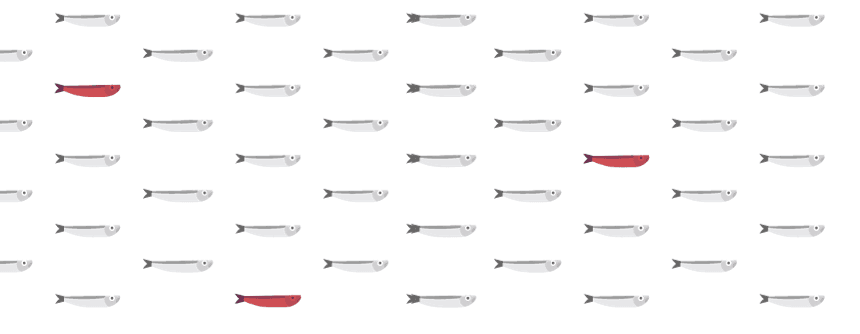December 4, 2023
5 min read
Navigating the deep waters of data: unraveling the mystery of red herrings
In the world of web analysis, deciphering data and uncovering valuable insights can be a challenging task, much like solving a puzzle.

In this article, we'll look into the origin of the term, understand what red herrings are in the context of digital behavioral analysis, provide examples, and discuss strategies to distinguish between real anomalies and mere distractions.
What is the origin of the term “Red herring“?
The term "red herring" has quite an interesting origin. There is no fish species called "red herring", rather it is a name given to a fish (usually herring) prepared in a particular way - strongly cured in brine or heavily smoked. This process gives the fish a strong smell and can even turn its flesh red. According to an old story, a pungent red herring was pulled along a trail until a puppy learned to follow the smell. Later, when the dog was being trained to track the faint odor of a fox or a badger, the trainer would drag a red herring across the animal's trail to confuse the dog with its strong scent. Eventually, the dog would figure out to stick to the original scent rather than getting distracted by the stronger one. This practice gave rise to the term "red herring" to describe a misleading clue that diverts attention from the real issue.

What are Red Herrings in Digital Behavioral Analysis
As in any other analytical field - in digital behavioral analysis red herrings are data points that may seem significant at first glance but, upon closer inspection, prove to be inconsequential or even misleading. These anomalies can arise from various sources, such as technical glitches, changes in user behavior, or random fluctuations. To better understand red herrings, let's explore a couple of examples:
Traffic spikes: Imagine noticing a sudden surge in website traffic. While it's tempting to celebrate this apparent popularity boost, it could be a red herring. The spike might result from a bot attack or a one-time event unrelated to genuine user interest.
Abnormal conversion rates: Suppose there's a sudden increase in conversion rates on your e-commerce website. Although it may initially seem cause for celebration, this could be a red herring if the spike is driven by a specific demographic or location that doesn't align with your target audience. Investigate whether these conversions are genuine or if they result from a technical glitch or fraudulent activity.
Engagement time and time-on-page anomalies: Parameters like time-on-page and engagement are often used to evaluate user interest in content. For instance, a sudden drop in time-on-page or engagement might be interpreted as users losing interest, but it could be caused by changing content and media so users can quickly find the information they seek. Alternatively, it might result from an auto-refresh feature that creates a new pageload in our tool while, for the user, it's still the same page and content.
Anomalies in Experience Metrics: In CUX, we use Experience metrics, such as Rage or Dead Clicks, Zooming, Chaotic Scrolling, and others to identify reasons behind user frustrations and gain valuable insights for website optimization. However, depending on the context of user behavior, these metrics can sometimes be red herrings. Imagine observing a spike in Rage Clicks on your product pages. The heatmap reveals that most of those clicks are concentrated around product gallery navigation arrows. While the initial conclusion might be that the element is broken, it could also be a way users navigate through your gallery—swiftly clicking on an arrow to reach a product picture they are interested in.
Explore insights on assessing user experience using Experience Metrics in our Knowledge Base article, How do I know the user experience on my website isn’t good?.
How to Distinguish Between Genuine Anomalies and Red Herrings
Identifying whether an anomaly is a red herring or a genuine cause for concern is crucial for effective digital behavior analysis. Here are some strategies to help differentiate between the two:
- Contextual understanding: Examine the anomaly in the context of your overall web data. Is it consistent with your website's typical patterns, or does it stand out as an aberration? Understanding the broader context can help assess the anomaly's significance.
- Correlation with events: Check if the anomaly coincides with any specific events, such as marketing campaigns, website updates, or external factors. Understanding the timeline can provide insights into the cause of the anomaly.
- User feedback and behavior analysis: Engage with user feedback and analyze user behavior data. If an anomaly corresponds with negative user experiences, it might be a genuine issue. On the other hand, if users are unaffected or unaware, it could be a red herring. The best way to do it in CUX is through visit recordings. CUX provides you with various sorting and filtering options that will help you to watch only those most relevant recordings and get to the answers as quickly as possible.
- Conduct long-term analysis: Leverage your analytical tools to dig deeper into the data. Look for patterns, correlations, and outliers. In CUX we recommend to extend the retention period to be able to validate whether an anomaly is a consistent trend or a one-time occurrence.
In the fascinating world of digital behavior analysis, red herrings may steer us off course if we don't spot and tackle them. By delving into their origin, exploring everyday examples, and using smart analysis strategies, web analysts can cut through the clutter. This helps them zero in on the valuable insights that shape well-informed decisions. The secret lies in approaching anomalies with a keen eye, always on the lookout for the real story behind the data.
